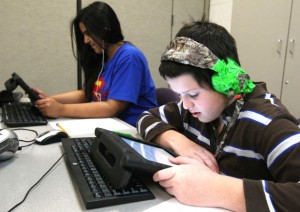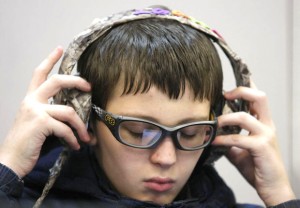Arcola Elementary placed top of all public schools in Learning Ally's Great Reading Games. The students' impressive feat of reading over 15,000 pages during the contest earned the attention of local media, including the following article written by Rachel Rodgers, which appeared in the Journal Gazette & Times-Courier and the Herald Review.
* * * * *
ARCOLA -- Special-education teacher
Rachel Stenger had never seen her students so excited to read.

Getting through books can be a frustrating task for students with learning disabilities, but within two months, children at Arcola Elementary School gained higher comprehension test scores and tackled texts above their reading level.
Through a partnership with national nonprofit Learning Ally and funds from the Illinois State Board of Education, the district offered students access to 80,000 audiobooks to help alleviate the struggles that stem from disabilities such as dyslexia or visual impairment.
“They're no longer faced with this huge, insurmountable challenge of decoding vocabulary,” Stenger said. “The kids are so motivated, and they've been reading feverishly at home and here (in the classroom).”
The students' efforts became recognized at the national level in early December as the school ranked second in Learning Ally's Great Reading Games contest for students with print disabilities.
Within six weeks, 62 students read 15,808 pages, an average of about 255 pages per child. First place went to Schenk School in Atlanta, a private institution for dyslexic children, with 302 students reading 24,624 pages.
“That makes us the top public school in the country, which is amazing, especially for a rural, small school to achieve,” she said.

The students spend at least 30 minutes a day on the Learning Ally program with their iPads, which they received in October as a part of the district's 1:1 Digital Learning Initiative, a project to individualize learning and increase engagement and critical thinking.
Eli Rodriguez, 11, who decorated his headphones with camouflage-patterned tape, said he finds reading more enjoyable now that he can flow through words he would normally stumble on.
“It helps me understand words I can't sometimes read like 'paragraph'; I didn't understand it until I heard it and read it at the same time,” he said.
For 12-year-old Gimena Mora, she usually skipped over words she couldn't read but said she is now more comfortable pursuing books with challenging vocabulary.
“I think it inspires us to read in a different form and use technology for more than just games,” she said.
The students are meeting their Accelerated Reader goals and scoring higher on the tests, Stenger said, and also have access to their class textbooks with the program.
“The biggest thing is that they're asking to read,” she said. “Student interest is a huge factor in reading, and they access books that interest them that they wouldn't be able to read independently.”
Being able to hear and see words at the same time is an invaluable resource for students with disabilities, and technological advances over the years have helped educators to meet exact needs and increase reading ability in the classroom, said special services director Cindy Mills.
“What we can do now with technology is unbelievable, compared with what we had when I went into education 20 years ago,” she said.
Community members raised more than $600,000 to fund the digital learning initiative.
Read the original article in the Journal Gazette & Times-Courier or the Herald Review.